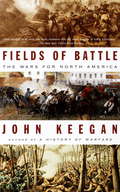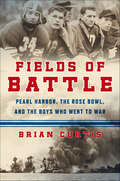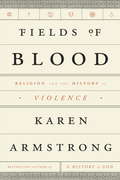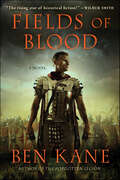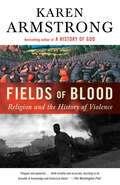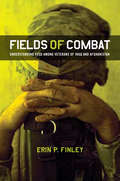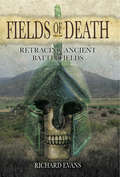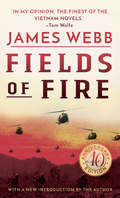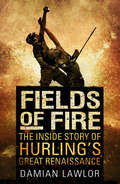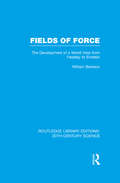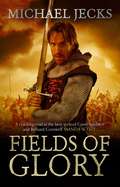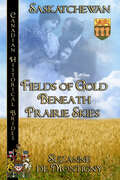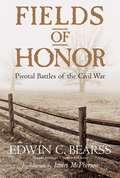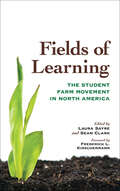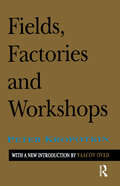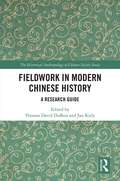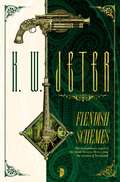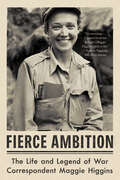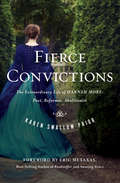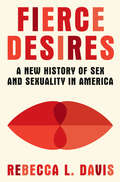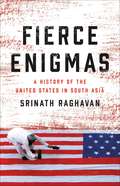- Table View
- List View
Fields of Battle
by John KeeganAt once a grand tour of the battlefields of North America and an unabashedly personal tribute to the military prowess of an essentially unwarlike people, Fields of Battle spans more than two centuries and the expanse of a continent to show how the immense spaces of North America shaped the wars that were fought on its soil. of photos.
Fields of Battle: Pearl Harbor, the Rose Bowl, and the Boys Who Went to War
by Brian CurtisA riveting story of football, wartime, and boys becoming men—from facing off in the 1942 Rose Bowl to serving together in WWII.In the wake of the bombing of Pearl Harbor, the 1942 Rose Bowl was moved from Pasadena to Durham, North Carolina, out of fear of Japanese attacks on the West Coast. Duke University faced off against underdog Oregon State College, with both teams preparing for a grueling fight on the football field while their thoughts drifted to the battlefields they would soon encounter.On New Year’s Day, the teams played one of the most unforgettable games in history. Shortly afterward, many of the players and coaches entered the military and would quickly become brothers on the battlefield. Scattered around the globe, the lives of Rose Bowl participants would intersect in surprising ways, as they served in Iwo Jima and Normandy, Guadalcanal and the Battle of the Bulge. In one powerful encounter, OSC’s Frank Parker saved the life of Duke’s Charles Haynes in Italy. And one OSC player, Jack Yoshihara, a Japanese-American, never had the chance to play in the game or serve his country, as he was sent to an internment camp in Idaho.In Fields of Battle, Brian Curtis sheds light on a little-known slice of American history with an intimate account of the teamwork, grit, and determination that took these men onto the gridiron and into combat.
Fields of Blood
by Karen ArmstrongFrom the renowned and bestselling author of A History of God, a sweeping exploration of religion's connection to violence. For the first time in American history, religious self-identification is on the decline. Some have cited a perception that began to grow after September 11: that faith in general is a source of aggression, intolerance and divisiveness--something bad for society. But how accurate is that view? And does it apply equally to all faiths? In these troubled times, we risk basing decisions of real and dangerous consequence on mistaken understandings of the faiths subscribed around us, in our immediate community as well as globally. And so, with her deep learning and sympathetic understanding, Karen Armstrong examines the impulse toward violence in each of the world's great religions. The comparative approach is new: while there have been plenty of books on jihad or the Crusades, this book lays the Christian and the Islamic way of war side by side, along with those of Buddhism, Hinduism, Confucianism, Daoism and Judaism. Each of these faiths arose in agrarian societies with plenty of motivation for violence: landowners had to lord it over peasants and warfare was essential to increase one's landholdings, the only real source of wealth before the great age of trade and commerce. In each context, it fell to the priestly class to legitimize the actions of the state. And so the martial ethos became bound up with the sacred. At the same time, however, their ideologies developed that ran counter to the warrior code: around sages, prophets and mystics. Within each tradition there grew up communities that represented a protest against the injustice and violence endemic to agrarian society. This book explores the symbiosis of these 2 impulses and its development as these confessional faiths came of age. The aggression of secularism has often damaged religion and pushed it into a violent mode. But modernity has also been spectacularly violent, and so Armstrong goes on to show how and in what measure religions, in their relative maturity, came to absorb modern belligerence--and what hope there might be for peace among believers in our time.
Fields of Blood: A Novel (Hannibal #2)
by Ben KaneHannibal's campaign to defeat Rome continues. Having brought his army safely over the Alps in winter, he now marches south to confront the enemy. With him is a young soldier, Hanno. Like his general, Hanno burns to vanquish Rome. Never has the possibility seemed so likely. Facing Hanno is his former friend, Quintus, whom Hanno met while in Roman captivity. A bitter quarrel with his father led Quintus to join the Roman infantry under an assumed name. Among his legionaries, he finds that his enemies are not just the Carthaginians, but men of his own side. A stealthy game of cat and mouse is being played, with Hannibal seeking to fight, and Rome's generals avoiding battle. But battle cannot be delayed for much longer. Eventually, the two armies meet under a fierce summer sun in August in the south of Italy. The place is Cannae-the fields of blood. The encounter will go down in history as one of the bloodiest battles ever fought, a battle in which Hanno and Quintus know they must fight as never before-just to stay alive.
Fields of Blood: Religion and the History of Violence
by Karen ArmstrongFrom the renowned and best-selling author of A History of God, a sweeping exploration of religion and the history of human violence. For the first time, religious self-identification is on the decline in American. Some analysts have cited as cause a post-9/11perception: that faith in general is a source of aggression, intolerance, and divisiveness--something bad for society. But how accurate is that view? With deep learning and sympathetic understanding, Karen Armstrong sets out to discover the truth about religion and violence in each of the world's great traditions, taking us on an astonishing journey from prehistoric times to the present. While many historians have looked at violence in connection with particular religious manifestations (jihad in Islam or Christianity's Crusades), Armstrong looks at each faith--not only Christianity and Islam, but also Buddhism, Hinduism, Confucianism, Daoism, and Judaism--in its totality over time. As she describes, each arose in an agrarian society with plenty powerful landowners brutalizing peasants while also warring among themselves over land, then the only real source of wealth. In this world, religion was not the discrete and personal matter it would become for us but rather something that permeated all aspects of society. And so it was that agrarian aggression, and the warrior ethos it begot, became bound up with observances of the sacred. In each tradition, however, a counterbalance to the warrior code also developed. Around sages, prophets, and mystics there grew up communities protesting the injustice and bloodshed endemic to agrarian society, the violence to which religion had become heir. And so by the time the great confessional faiths came of age, all understood themselves as ultimately devoted to peace, equality, and reconciliation, whatever the acts of violence perpetrated in their name.Industrialization and modernity have ushered in an epoch of spectacular and unexampled violence, although, as Armstrong explains, relatively little of it can be ascribed directly to religion. Nevertheless, she shows us how and in what measure religions, in their relative maturity, came to absorb modern belligerence--and what hope there might be for peace among believers of different creeds in our time.At a moment of rising geopolitical chaos, the imperative of mutual understanding between nations and faith communities has never been more urgent, the dangers of action based on misunderstanding never greater. Informed by Armstrong's sweeping erudition and personal commitment to the promotion of compassion, Fields of Blood makes vividly clear that religion is not the problem.From the Hardcover edition.
Fields of Combat: Understanding PTSD among Veterans of Iraq and Afghanistan (The Culture and Politics of Health Care Work)
by Erin P. Finley"If you consider Iraq—like I do, probably twenty-nine out of thirty days—to be the pinnacle of your life, then where do you go from there? And I'm sure that a lot of veterans feel that way. To them, that was it. That was everything. So now what? They have to find something meaningful and purposeful.""When I got back from Afghanistan, there was not even so much as a briefing that said, 'Let us know if you're having problems.' There wasn't so much as a phone number. There was literally nothing.""I knew it was crazy. I was thinking, the guy on the roof's either a sniper or he's going to radio ahead. And then I thought, this is San Antonio. There's not snipers on the roof, nobody's going to blow me up here.""Whenever I look at people back here at home, I know what they're going to look like dead. I know what they look like with their brains blown out or jaws blown off or eyes pulled out. When I look at somebody I see that, to this day."—Voices of veterans interviewed in Fields of CombatFor many of the 1.6 million U.S. service members who have served in Iraq and Afghanistan since 2001, the trip home is only the beginning of a longer journey. Many undergo an awkward period of readjustment to civilian life after long deployments. Some veterans may find themselves drinking too much, unable to sleep or waking from unspeakable dreams, lashing out at friends and loved ones. Over time, some will struggle so profoundly that they eventually are diagnosed with post-traumatic stress Disorder (PTSD).Both heartbreaking and hopeful, Fields of Combat tells the story of how American veterans and their families navigate the return home. Following a group of veterans and their personal stories of war, trauma, and recovery, Erin P. Finley illustrates the devastating impact PTSD can have on veterans and their families. Finley sensitively explores issues of substance abuse, failed relationships, domestic violence, and even suicide and also challenges popular ideas of PTSD as incurable and permanently debilitating. Drawing on rich, often searing ethnographic material, Finley examines the cultural, political, and historical influences that shape individual experiences of PTSD and how its sufferers are perceived by the military, medical personnel, and society at large. Despite widespread media coverage and public controversy over the military's response to wounded and traumatized service members, debate continues over how best to provide treatment and compensation for service-related disabilities. Meanwhile, new and highly effective treatments are revolutionizing how the Department of Veterans Affairs (VA) provides trauma care, redefining the way PTSD itself is understood in the process. Carefully and compassionately untangling each of these conflicts, Fields of Combat reveals the very real implications they have for veterans living with PTSD and offers recommendations to improve how we care for this vulnerable but resilient population.
Fields of Death: Retracing Ancient Battlefields
by Richard EvansRichard Evans revisits the sites of a selection of Greek and Roman battles and sieges to seek new insights. The battle narratives in ancient sources can be a thrilling read and form the basis of our knowledge of these epic events, but they can just as often provide an incomplete or obscure record. Details, especially those related to topographical and geographical issues which can have a fundamental importance to military actions, are left tantalisingly unclear to the modern reader. The evidence from archaeological excavation work can sometimes fill in a gap in our understanding, but such an approach remains uncommon in studying ancient battles. By combining the ancient sources and latest archaeological findings with his personal observations on the ground, Richard Evans brings new perspectives to the dramatic events of the distant past. For example, why did armies miss one another in what we might today consider relatively benign terrain? Just how important was the terrain in determining victory or defeat in these clashes.The author has carefully selected battles and sieges to explore, first of all to identify their locations and see how these fit with the ancient evidence. He then examines the historical episodes themselves, offering new observations from first-hand study of the field of battle along with up-to-date photographs, maps and diagrams. In the process he discusses whether and how the terrain has since been changed by land use, erosion and other factors, and the extent to which what we see today represents a real connection with the dramatic events of the distant past. This first volume considers: 1. The Greek Victory over the Persians at Marathon (490 BC)2. Leonidas and his Three Hundred Spartans at Thermopylae (480 BC)3. The Athenian Siege of Syracuse (414-413 BC)4. The Syracusan Siege of Motya (397 BC)5. Alexander's Defeat of Darius at Issus (333 BC)6. Hannibal's Victory at Cannae (216 BC)7. Titus Quinctius Flamininus and Philip V at Cynoscephalae (197 BC)8. Gaius Marius' Victory over the Teutones at Aquae Sextiae (102 BC)9. Octavian versus Antony and Cleopatra of Egypt: The Battle of Actium (31 BC)10. The First Battle of Bedriacum (April AD 69)
Fields of Fire
by Terry CoppWith Fields of Fire, Terry Copp challenges the conventional view that the Canadian contribution to the Battle of Normandy was a "failure" - that the allies won only through the use of brute force, and that the Canadian soldiers and commanding officers were essentially incompetent. His detailed and impeccably researched analysis of what actually happened on the battlefield portrays a flexible, innovative army that made a major, and successful, contribution to the defeat of the German forces in just seventy-six days.Challenging both existing interpretations of the campaign and current approaches to military history, Copp examines the Battle of Normandy, tracking the soldiers over the battlefield terrain and providing an account of each operation carried out by the Canadian army. In so doing, he illustrates the valour, skill, and commitment of the Allied citizen-soldier in the face of a well-entrenched and well-equipped enemy army.This new edition of Copp's best-selling, award-winning history includes a new introduction that examines the strategic background of the Battle of Normandy.
Fields of Fire: A Novel (A\mayflower Book Ser.)
by James WebbThey each had their reasons for being a soldier.They each had their illusions. Goodrich came from Harvard. Snake got the tattoo -- Death Before Dishonor -- before he got the uniform. And Hodges was haunted by the ghosts of family heroes.They were three young men from different worlds plunged into a white-hot, murderous realm of jungle warfare as it was fought by one Marine platoon in the An Hoa Basin, 1969. They had no way of knowing what awaited them. Nothing could have prepared them for the madness to come. And in the heat and horror of battle they took on new identities, took on each other, and were each reborn in fields of fire....Fields of Fire is James Webb's classic, searing novel of the Vietnam War, a novel of poetic power, razor-sharp observation, and agonizing human truths seen through the prism of nonstop combat. Weaving together a cast of vivid characters, Fields of Fire captures the journey of unformed men through a man-made hell -- until each man finds his fate.From the Paperback edition.
Fields of Fire: The Inside Story of Hurling's Great Renaissance
by Damian LawlorThese are exceptional times for the game of hurling. The skill, speed and summer long edge of the seat drama of recent All Ireland championships has led many to conclude that something very special is happening in the ancient game.The Kilkenny team of the last decade has undoubtedly been the greatest in the history of hurling. Their extraordinary record speaks for itself. But has a chink finally begun to appear in Kilkenny’s armour? Or is it that the challengers have begun to catch up, at last recognising the immense effort required to compete at the highest level?Fields Of Fire tells the story of Kilkenny’s phenomenal success and explores how the Cats became an almost indomitable force. But it also looks at the profound challenge which their supremacy presented to other counties, revealing how the struggle for competitiveness has positively transformed the game. Old rivals have adapted and learned. But new powers too have emerged – from Clare and from Limerick, from Dublin and from Waterford - young bloods who do not fear the Kings of the Game.Drawing on exclusive interviews with dozens of current and former legends, among them Eddie Brennan, Cha Fitzpatrick, Brendan Cummins, John Mullane, Davy Fitzgerald, Damien Hayes, Liam Dunne, DJ Carey and Ger Cunningham, award-winning journalist Damian Lawlor offers a unique and compelling insight into hurling’s spectacular renaissance.
Fields of Force: The Development of a World View from Faraday to Einstein. (Routledge Library Editions: 20th Century Science)
by William BerksonThis book describes the picture of reality given by Newton, and the development of the later picture of reality given by field theory. In telling this story, the author explains what problem each scientist faced, and how the process of solving them led to new discoveries. By this method he gives unique insight into the understanding of Einstein’s special theory of relativity, as he explains exactly what problems led to the invention of the theory, and exactly where Einstein’s solution differed from his predecessors’. A similar analysis is given of the discoveries of Faraday, Maxwell, Hertz and Lorentz. The problem-oriented approach of the book, originally published in 1974, enables the reader to share in the original creative process, and in the excitement of the discoveries. It puts physics problems into new perspective and discusses the philosophical implications of the history - an illuminating account of a great episode in the history of thought.
Fields of Fortune: 'Viking' Farmers in America
by Robert DodgeA gripping history of one Norwegian immigrant family’s experience in the United States from the mid-nineteenth century to World War II.In the spring of 1853, a family of eight drove their wagon to the wharf in Bergen, Norway. They unloaded their belongings alongside the other stacks labeled, AMERICA, MINNESOTA, ILLINOIS, MICHIGAN, NEW YORK CITY, CHICAGO and boarded the crowded ship.Hopeful, nervous Norwegians—giving up everything for a place they knew of only through second-hand tales of freedom and opportunity—watched as the shoreline retreated, knowing they would never see their homeland again. Their trip ahead would be spent in cramped conditions for two or three months until they reached Ellis Island. The United States, where they were immigrating to, was facing many problems including tensions over slavery and the subsequent beginning of the Civil War.The family moved west to farm the free land that was offered to them but were met with resistance, as it was land that had been cultivated by Native Americans for thousands of years before. The family was nearly eliminated during these times, often referred to as the American Indian Wars.Future generations carried on to the Dakotas and Alberta with difficulties. These Norwegians persisted. Through ardent research and narrative biography, Robert Dodge reflects on the immigrant experience of one Norwegian family from the mid-nineteenth century through World War II in Fields of Fortune: ‘Viking’ Farmers in America.Praise for Fields of Fortune“A thriller, a family adventure, a Viking heritage story that kept me turning the pages and asking for more.” —Alice C. Schelling, author of Hiding Alinka“A riveting tale . . . featuring strong women who carried their families forward even when their men failed them.” —Carolyn Bradley Bursack, author of Minding Our Elders“Award–winning author Robert Doge doesn’t just write history, he paints it in true story-telling style.” —Jodi Bowersox, president of the Colorado Authors League
Fields of Glory
by Michael JecksA stunning new series from Michael Jecks, perfect for fans of Bernard Cornwell and Conn Iggulden. The year is 1346 and King Edward III is restless. Despite earlier victories his army has still not achieved a major breakthrough and the French crown remains intact. Determined to bring France under English rule and the French army to its knees he has regrouped and planned a new route of attack. And on the beaches of Normandy his men now mass, ready to march through France to victory. But the French are nowhere to be seen. Edward knows that the worst thing he could do would be to take the battle to the French, where they will have the advantage and so he sets up camp near a small hill at Crecy and waits. The Battle of Crecy will be a decisive turning point in the Hundred Years' Wars. This is the story of that battle and the men who won it. Praise for Templar's Acre'A cracking read in the best style of Conn Iggulden and Bernard Cornwell, this will delight existing fans and bring many more to the fold' Manda Scott'Vivid imagination and gripping prose' Anthony Riches'Compellingly brought to life - both bloody reality and glorious courage' Julian Stockwin 'The Siege of Acre is meticulously observed and bloodily rendered. I want more' Robert Low
Fields of Gold Beneath Prairie Skies: Canadian Historical Brides (Canadian Historical Brides #6)
by Suzanne De MontignyFrench-Canadian soldier, Napoleon, proposes to Lea during WWI, promising golden fields of wheat as far as the eye can see. After the armistice, he sends money for her passage, and she journeys far from her family and the conveniences of a modern country to join him on a homestead in Saskatchewan. There, she works hard to build their dream of a prospering farm, clearing fields alongside her husband through several pregnancies and even after suffering a terrible loss. When the stock market crashes in ’29, the prairies are stricken by a long and abysmal drought. Thrown into poverty, she struggles to survive in a world where work is scarce, death is abundant, and hope dwindles. Will she and her family survive the Great Depression?
Fields of Gold Beneath Prairie Skies: Canadian Historical Brides (Canadian Historical Brides #6)
by de MontignyFrench-Canadian soldier, Napoleon, proposes to Lea during WWI, promising golden fields of wheat as far as the eye can see. After the armistice, he sends money for her passage, and she journeys far from her family and the conveniences of a modern country to join him on a homestead in Saskatchewan. There, she works hard to build their dream of a prospering farm, clearing fields alongside her husband through several pregnancies and even after suffering a terrible loss. When the stock market crashes in ’29, the prairies are stricken by a long and abysmal drought. Thrown into poverty, she struggles to survive in a world where work is scarce, death is abundant, and hope dwindles. Will she and her family survive the Great Depression?
Fields of Honor
by Edwin C. BearssFew historians have ever captured the drama, excitement, and tragedy of the Civil War with the headlong elan of Edwin Bearss, who has won a huge, devoted following with his extraordinary battlefield tours and eloquent soliloquies about the heroes, scoundrels, and little-known moments of a conflict that still fascinates America. Antietam, Shiloh, Gettysburg: these hallowed battles and more than a dozen more come alive as never before, rich with human interest and colorful detail culled from a lifetime of study.Illustrated with detailed maps and archival images, this 448-page volume presents a unique narrative of the Civil War's most critical battles, translating Bearss' inimitable delivery into print. As he guides readers from the first shots at Fort Sumter to Gettysburg's bloody fields to the dignified surrender at Appomattox, his engagingly plainspoken but expert account demonstrates why he stands beside Shelby Foote, James McPherson, and Ken Burns in the front rank of modern chroniclers of the Civil War, as the Pulitzer Prize-winning McPherson himself points out in his admiring Introduction.A must for every one of America's countless Civil War buffs, this major work will stand as an important reference and enduring legacy of a great historian for generations to come.
Fields of Learning: The Student Farm Movement in North America (Culture Of The Land Ser.)
by Laura Sayre and Sean Clark“Essays from staff on 15 farms . . . illustrate the trials, tribulations and sheer joys of establishing and maintaining such enterprises.” —USA TodayOriginally published in 2011, Fields of Learning remains the single best resource for students, faculty, and administrators involved in starting or supporting campus farms. Featuring detailed profiles of fifteen diverse student farms on college and university campuses across North America, the book also serves as a history of the student farm movement, showing how the idea of campus farms has come in and out of fashion over the past century and how the tenacious work of students, faculty, and other campus community members has upheld and reimagined the objectives of student farming over time. Ranging in size from less than an acre to hundreds of acres, supplying food to campus dining halls or community food banks, and hosting scientific research projects or youth education programs, student farms highlight the interdisciplinary richness and multifunctionality of agriculture, supporting academic work across a range of fields while simultaneously building community engagement and stimulating critical conversations about environmental and social justice. As institutions of higher learning face new challenges linked to the global climate crisis and public health emergency, this book holds continued relevance for readers in North America and beyond.“A timely and hopeful book.” —Jason Peters, editor of Wendell Berry: Life and Work“The opportunity for students to spend time learning on campus farms is not just a good idea—it should be mandatory.” —Gary Hirshberg, President & CEO, Stonyfield Farm“An excellent book, useful for anyone interested in the past, or the future, of the student farm movement.” —Journal of Agricultural & Food Information
Fields, Factories, and Workshops
by Peter KropotkinPrince Peter Kropotkin (1842-1921) was the most outstanding anarchist thinker of his time. His writings, which combine revolutionary fervor with intellectual rigor, were influential far beyond the bounds of the anarchist movement. No mere propagandist, Kropotkin aimed to provide anarchism with a scientific base through research of dominant tendencis in society. This text is a meticulously researched and argued outline for redirecting agricultural and industrial production in a world of shrinking resources and increasing human needs. More prophetic than utopian, this volume remains remarkably pertinent to economic conditions at the end of the twentieth century. The analysis of trends at work in the United States, Japan and China are of amazing predictive power.
Fieldwork in Modern Chinese History: A Research Guide (The Historical Anthropology of Chinese Society Series)
by Jan Kiely Thomas David DuBoisThis book explores how fieldwork has been used to research Chinese history in the past and new ways that others might use in it the future. It introduces the previous generations of scholars who ventured out of the archive to conduct local investigations in Chinese cities, villages, farms and temples. It goes on to present the techniques of historical fieldwork, providing guidance on how to integrate oral history into research plans and archival research, conduct interviews, and locate sources in the field. Chapters by established researchers relate these techniques to specific types of fieldwork, including religion, the imperial past, natural environments and agriculture. Combining the past and the future of the craft, the book provides a rich resource for scholars coming new to fieldwork in the history of China.
Fiendish Schemes
by K. W. JeterFirst British publication of the sequel to Infernal Devices, to mark the 30th anniversary of Steampunk. The world George Dower left when he went into hiding was significantly simpler than the new, steam-powered Victorian London. Dower is enticed into a web of intrigue with ominously mysterious players who have nefarious plans of which he can only guess. If he can locate and make his father's Vox Universalis work as it was intended, his future is assured. But his efforts are confounded by the strange Vicar Stonebrake. Drugged, arrested, and interrogated Dower is trapped in a maelstrom of secrets, corruption, and schemes that threaten to drown him in the chaos of this mad new world.File Under: Steampunk [ A Plague of Lighthouses | Sexual Healing | The lady's Not For Turning | End of the World, Again ]
Fierce Ambition: The Life and Legend of War Correspondent Maggie Higgins
by Jennet Conant“Mesmerizing.… Conant’s book has brought [Maggie Higgins] back to life.” —Andrew Nagorski, Wall Street Journal A spirited portrait of twentieth-century war correspondent Maggie Higgins and her tenacious fight to the top in a male-dominated profession. Marguerite Higgins was both the scourge and envy of the journalistic world. A longtime reporter for the New York Herald Tribune, she first catapulted to fame with her dramatic account of the liberation of Dachau at the end of World War II. Brash, beautiful, ruthlessly competitive, and sexually adventurous, she forced her way to the front despite being told the combat zone was no place for a woman. Her headline-making exploits earned her a reputation for bravery bordering on recklessness and accusations of “advancing on her back,” trading sexual favors for scoops. While the Herald Tribune exploited her feminine appeal—regularly featuring the photogenic "girl reporter" on its front pages—it was Maggie’s dogged determination, talent for breaking news, and unwavering ambition that brought her success from one war zone to another. Her notoriety soared during the Cold War, and her daring dispatches from Korea garnered a Pulitzer Prize for foreign correspondence—the first granted to a woman for frontline reporting—with the citation noting the unusual dangers and difficulties she faced because of her sex. A star reporter, she became part of the Kennedy brothers’ Washington circle, though her personal alliances and politics provoked bitter feuds with male rivals, who vilified her until her untimely death. Drawing on new and extensive research, including never-before-published correspondence and interviews with Maggie’s colleagues, lovers, and soldiers and generals who knew her in the field, journalist and historian Jennet Conant restores Maggie’s rightful place in history as a woman who paved the way for the next generation of journalists, and one of the greatest war correspondents of her time.
Fierce Convictions: The Extraordinary Life of Hannah More? Poet, Reformer, Abolitionist
by Karen Swallow PriorWith a foreword by Eric Metaxas, best-selling author of Bonhoeffer and Amazing Grace.The enthralling biography of the woman writer who helped end the slave trade, changed Britain&’s upper classes, and taught a nation how to read.The history-changing reforms of Hannah More affected every level of 18th-Century British society through her keen intellect, literary achievements, collaborative spirit, strong Christian principles, and colorful personality. A woman without connections or status, More took the world of British letters by storm when she arrived in London from Bristol, becoming a best-selling author and acclaimed playwright and quickly befriending the author Samuel Johnson, the politician Horace Walpole, and the actor David Garrick. Yet she was also a leader in the Evangelical movement, using her cultural position and her pen to support the growth of education for the poor, the reform of morals and manners, and the abolition of Britain&’s slave trade. Fierce Convictions weaves together world and personal history into a stirring story of life that intersected with Wesley and Whitefield&’s Great Awakening, the rise and influence of Evangelicalism, and convulsive effects of the French Revolution. A woman of exceptional intellectual gifts and literary talent, Hannah More was above all a person whose faith compelled her both to engage her culture and to transform it.
Fierce Desires: A New History of Sex and Sexuality in America
by Rebecca L. DavisFrom an esteemed scholar, a richly textured, authoritative history of sex and sexuality in America—the first major account in three decades. Our era is one of sexual upheaval. Roe v. Wade was overturned in the summer of 2022, school systems across the country are banning books with LGBTQ+ themes, and the notion of a “tradwife” is gaining adherents on the right while polyamory wins converts on the left. It may seem as though debates over sex are more intense than ever, but as acclaimed historian Rebecca L. Davis demonstrates in Fierce Desires, we should not be too surprised, because Americans have been arguing over which kinds of sex are “acceptable”—and which are not—since before the founding itself. From the public floggings of fornicators in early New England to passionate same-sex love affairs in the 1800s and the crackdown on abortion providers in the 1870s, and from the movements for sexual liberation to the recent restrictions on access to gender affirming care, Davis presents a sweeping, engrossing, illuminating four-hundred-year account of this nation’s sexual past. Drawing on a wealth of sources, including legal records, erotica, and eighteenth-century romance novels, she recasts important episodes—Anthony Comstock’s crusade against smut among them—and, at the same time, unearths stories of little-remembered pioneers and iconoclasts, such as an indentured servant in colonial Virginia named Thomas/Thomasine Hall, Gay Liberation Front cofounder Kiyoshi Kuromiya, and postwar female pleasure activist Betty Dodson. At the heart of the book is Davis’s argument that the concept of sexual identity is relatively novel, first appearing in the nineteenth century. Over the centuries, Americans have shifted from understanding sexual behaviors as reflections of personal preferences or values, such as those rooted in faith or culture, to defining sexuality as an essential part of what makes a person who they are. And at every step, legislators, police, activists, and bureaucrats attempted to regulate new sexual behaviors, transforming government in the process. The most comprehensive account of America’s sexual past since John D’Emilio and Estelle Freedman’s 1988 classic, Intimate Matters, Davis’s magisterial work seeks to help us understand the turmoil of the present. It demonstrates how fiercely we have always valued our desires, and how far we are willing to go to defend them.
Fierce Eden
by Jennifer BlakeBeautiful Elise Laffont seems too young and alive to be a widow at the ageof twenty-five. But she is not grieving the loss of her husband. The manhad been a complete cad, abusing her delicate womanhood until she could not stand the thought of a man's desire. And so, despite her youth she isquite content to remain alone, managing her small Louisiana farm undisturbed. Just when Elise has begun to eke out a small bit of independence for herself, an uprising of the fierce Natchez Indians forcesher to flee the farm, which represents all the happiness she has ever known. In order to escape massacre, she must become the mistress of a frighteningly commanding half-blood... Reynaud Chavalier is the son of a French nobleman and a Natchez princess. His imposing stature and rugged masculine beauty prove irresistible to Elise. But with her history of abuse at the hands of her late husband, will she allow herself to be calmed by his reassuring caresses? All she wants is to be left alone...until she feels the power of true love.
Fierce Enigmas: A History of the United States in South Asia
by Srinath RaghavanThe two-hundred-year history of the United States' involvement in South Asia--the key to understanding contemporary American policy in the region South Asia looms large in American foreign policy. Over the past two decades, we have spent billions of dollars and thousands of human lives in the region, to seemingly little effect. As Srinath Raghavan reveals in Fierce Enigmas, this should not surprise us. For 230 years, America's engagement with India, Afghanistan, and Pakistan has been characterized by short-term thinking and unintended consequences. Beginning with American traders in India in the eighteenth century, the region has become a locus for American efforts--secular and religious--to remake the world in its image. The definitive history of US involvement in South Asia, Fierce Enigmas is also a clarion call to fundamentally rethink our approach to the region.
